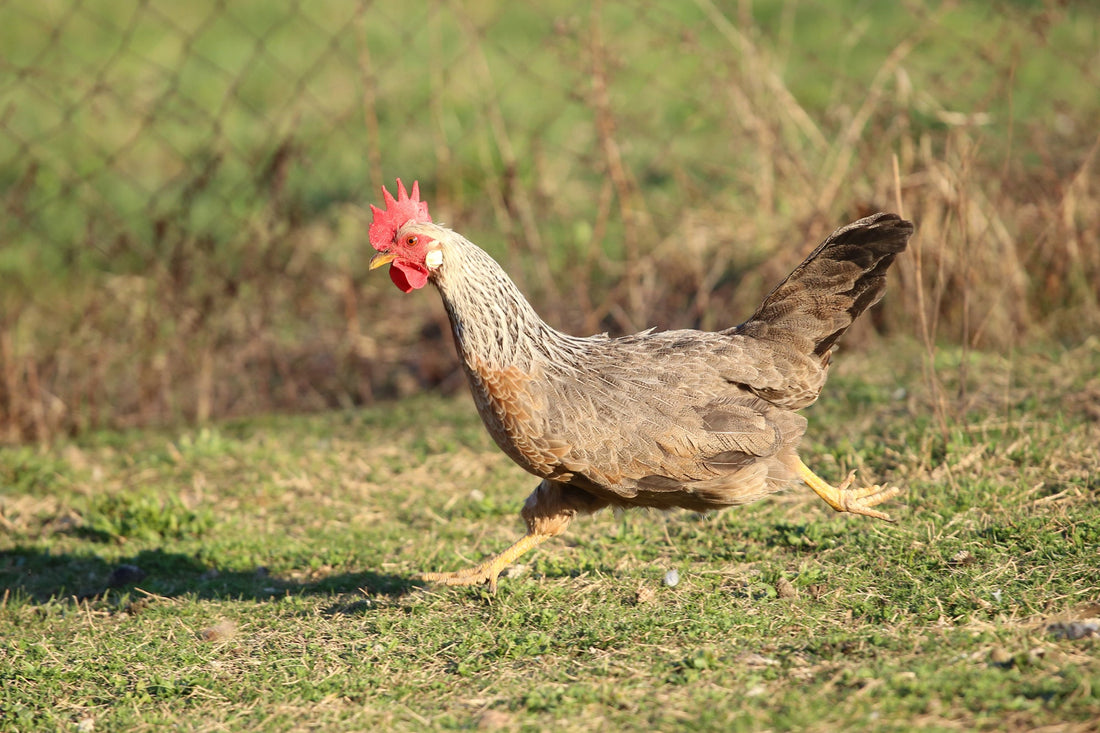Chickens are often underestimated when it comes to their agility and speed. While they may have a reputation for their leisurely waddle, these feathered creatures possess remarkable athletic abilities that allow them to move with surprising agility and speed. In this article, we'll take a closer look at the hidden talents of chickens, exploring their quick movements, impressive reflexes, and the factors that contribute to their remarkable speed.
The Need for Speed: Understanding Chicken Agility
Contrary to popular belief, chickens are not sluggish creatures. In fact, they are remarkably agile and quick on their feet, with the ability to reach impressive speeds when motivated or threatened. Their agility is a result of their anatomical adaptations, including lightweight bodies, strong leg muscles, and flexible joints. Chickens also possess excellent balance and coordination, allowing them to navigate uneven terrain and obstacles with ease. Whether evading predators, chasing after prey, or simply exploring their surroundings, chickens rely on their agility to move swiftly and efficiently.
The Anatomy of Speed: Exploring Chicken Physiology
The anatomy of chickens is finely tuned for speed and agility. Their lightweight bodies are supported by powerful leg muscles, enabling them to generate rapid bursts of movement. Chickens have strong, flexible joints that provide a wide range of motion, allowing them to make quick turns and changes in direction. Their feet are equipped with sharp claws that provide traction on various surfaces, enhancing their grip and stability while running. Additionally, chickens have well-developed sensory organs, including keen eyesight and acute hearing, which help them detect and react to potential threats or opportunities for movement.
The Art of Evasion: Escaping Predators
One of the primary reasons for chickens' agility is their natural instinct for self-preservation. In the wild, chickens face constant threats from predators such as foxes, hawks, and snakes. To evade capture, chickens rely on their speed and agility to outmanoeuvre their adversaries. When confronted with danger, chickens will often take flight or sprint to safety, utilizing their rapid movements and evasive tactics to avoid capture. Their ability to dart through narrow openings, leap over obstacles, and change direction quickly can mean the difference between life and death in the face of a predator.
Racing to the Finish: Chicken Sprints
Chickens are not only adept at evading predators but also at engaging in friendly competitions among themselves. Chicken races, or sprints, are a popular form of entertainment and a testament to their speed and agility. In these races, chickens compete to see who can cover a specified distance in the shortest amount of time. Owners and spectators alike marvel at the sight of these feathered athletes as they dash across the finish line with astonishing speed. Chicken sprints are not only entertaining but also showcase the natural talents and athleticism of these remarkable birds.
From Farm to Field: Agile Foragers
On the farm or in free-range settings, chickens rely on their agility to forage for food and explore their environment. They use their keen senses to detect insects, seeds, and other tasty morsels hidden in the grass or soil. With lightning-fast movements, chickens will scratch, peck, and dart about as they hunt for sustenance. Their agility allows them to cover large areas of ground efficiently, ensuring they have access to a diverse range of nutrients and resources. Whether chasing after a juicy bug or snatching up a fallen fruit, chickens' quick reflexes and nimble movements serve them well in their foraging endeavors.
Training and Conditioning: Enhancing Agility
While chickens naturally possess agility and speed, their athletic abilities can be further enhanced through training and conditioning. By providing opportunities for exercise and movement, such as free-ranging or supervised play sessions, owners can help chickens develop and maintain their agility. Agility training exercises, such as setting up obstacle courses or encouraging chickens to navigate through tunnels and ramps, can improve their coordination, balance, and speed. Additionally, incorporating toys and enrichment activities into their environment can stimulate their minds and bodies, keeping them mentally sharp and physically fit.
Factors Influencing Agility: Genetics and Environment
The agility of chickens is influenced by a combination of genetic factors and environmental conditions. Certain breeds of chickens are naturally more agile than others, with some exhibiting traits such as heightened reflexes or greater endurance. Environmental factors, such as diet, housing conditions, and access to space, can also impact chickens' agility and overall athleticism. Providing a nutritious diet rich in protein and essential nutrients, along with ample opportunities for exercise and exploration, can support the development of healthy, agile chickens.
Appreciating Chicken Agility: A Source of Amazement
The surprising speed and agility of chickens are a testament to their remarkable adaptability and resilience. Whether evading predators, engaging in friendly races, or foraging for food, chickens rely on their quick reflexes and nimble movements to navigate their world with confidence and grace. By understanding the factors that contribute to their agility and providing opportunities for exercise and enrichment, we can appreciate and celebrate the incredible talents of these feathered athletes.
Chickens are often underestimated when it comes to their agility and speed. While they may have a reputation for their leisurely waddle, these feathered creatures possess remarkable athletic abilities that allow them to move with surprising agility and speed. In this article, we'll take a closer look at the hidden talents of chickens, exploring their quick movements, impressive reflexes, and the factors that contribute to their remarkable speed.
The Need for Speed: Understanding Chicken Agility
Contrary to popular belief, chickens are not sluggish creatures. In fact, they are remarkably agile and quick on their feet, with the ability to reach impressive speeds when motivated or threatened. Their agility is a result of their anatomical adaptations, including lightweight bodies, strong leg muscles, and flexible joints. Chickens also possess excellent balance and coordination, allowing them to navigate uneven terrain and obstacles with ease. Whether evading predators, chasing after prey, or simply exploring their surroundings, chickens rely on their agility to move swiftly and efficiently.
The Anatomy of Speed: Exploring Chicken Physiology
The anatomy of chickens is finely tuned for speed and agility. Their lightweight bodies are supported by powerful leg muscles, enabling them to generate rapid bursts of movement. Chickens have strong, flexible joints that provide a wide range of motion, allowing them to make quick turns and changes in direction. Their feet are equipped with sharp claws that provide traction on various surfaces, enhancing their grip and stability while running. Additionally, chickens have well-developed sensory organs, including keen eyesight and acute hearing, which help them detect and react to potential threats or opportunities for movement.
The Art of Evasion: Escaping Predators
One of the primary reasons for chickens' agility is their natural instinct for self-preservation. In the wild, chickens face constant threats from predators such as foxes, hawks, and snakes. To evade capture, chickens rely on their speed and agility to outmanoeuvre their adversaries. When confronted with danger, chickens will often take flight or sprint to safety, utilizing their rapid movements and evasive tactics to avoid capture. Their ability to dart through narrow openings, leap over obstacles, and change direction quickly can mean the difference between life and death in the face of a predator.
Racing to the Finish: Chicken Sprints
Chickens are not only adept at evading predators but also at engaging in friendly competitions among themselves. Chicken races, or sprints, are a popular form of entertainment and a testament to their speed and agility. In these races, chickens compete to see who can cover a specified distance in the shortest amount of time. Owners and spectators alike marvel at the sight of these feathered athletes as they dash across the finish line with astonishing speed. Chicken sprints are not only entertaining but also showcase the natural talents and athleticism of these remarkable birds.
From Farm to Field: Agile Foragers
On the farm or in free-range settings, chickens rely on their agility to forage for food and explore their environment. They use their keen senses to detect insects, seeds, and other tasty morsels hidden in the grass or soil. With lightning-fast movements, chickens will scratch, peck, and dart about as they hunt for sustenance. Their agility allows them to cover large areas of ground efficiently, ensuring they have access to a diverse range of nutrients and resources. Whether chasing after a juicy bug or snatching up a fallen fruit, chickens' quick reflexes and nimble movements serve them well in their foraging endeavors.
Training and Conditioning: Enhancing Agility
While chickens naturally possess agility and speed, their athletic abilities can be further enhanced through training and conditioning. By providing opportunities for exercise and movement, such as free-ranging or supervised play sessions, owners can help chickens develop and maintain their agility. Agility training exercises, such as setting up obstacle courses or encouraging chickens to navigate through tunnels and ramps, can improve their coordination, balance, and speed. Additionally, incorporating toys and enrichment activities into their environment can stimulate their minds and bodies, keeping them mentally sharp and physically fit.
Factors Influencing Agility: Genetics and Environment
The agility of chickens is influenced by a combination of genetic factors and environmental conditions. Certain breeds of chickens are naturally more agile than others, with some exhibiting traits such as heightened reflexes or greater endurance. Environmental factors, such as diet, housing conditions, and access to space, can also impact chickens' agility and overall athleticism. Providing a nutritious diet rich in protein and essential nutrients, along with ample opportunities for exercise and exploration, can support the development of healthy, agile chickens.
Appreciating Chicken Agility: A Source of Amazement
The surprising speed and agility of chickens are a testament to their remarkable adaptability and resilience. Whether evading predators, engaging in friendly races, or foraging for food, chickens rely on their quick reflexes and nimble movements to navigate their world with confidence and grace. By understanding the factors that contribute to their agility and providing opportunities for exercise and enrichment, we can appreciate and celebrate the incredible talents of these feathered athletes.

